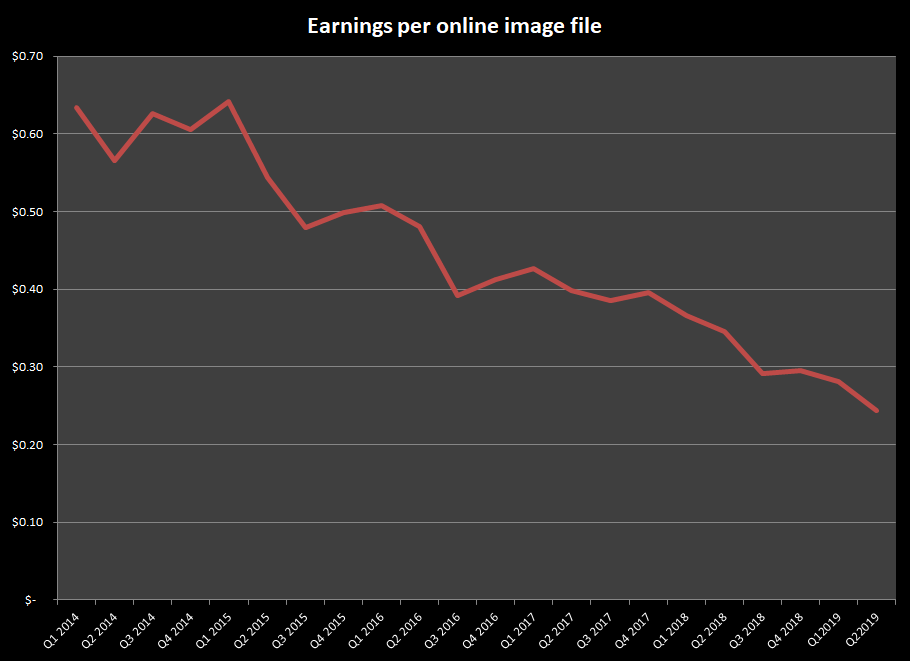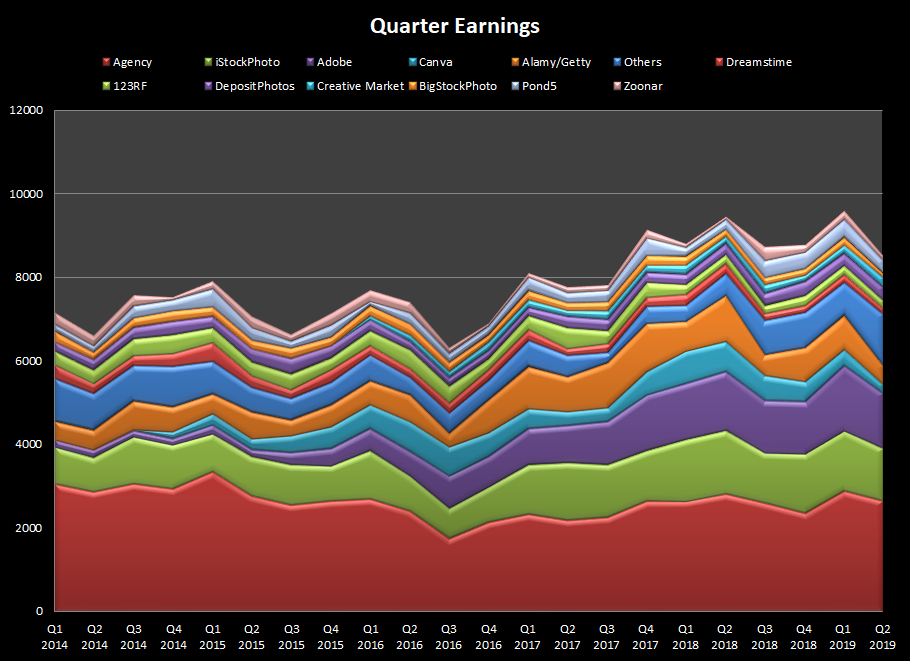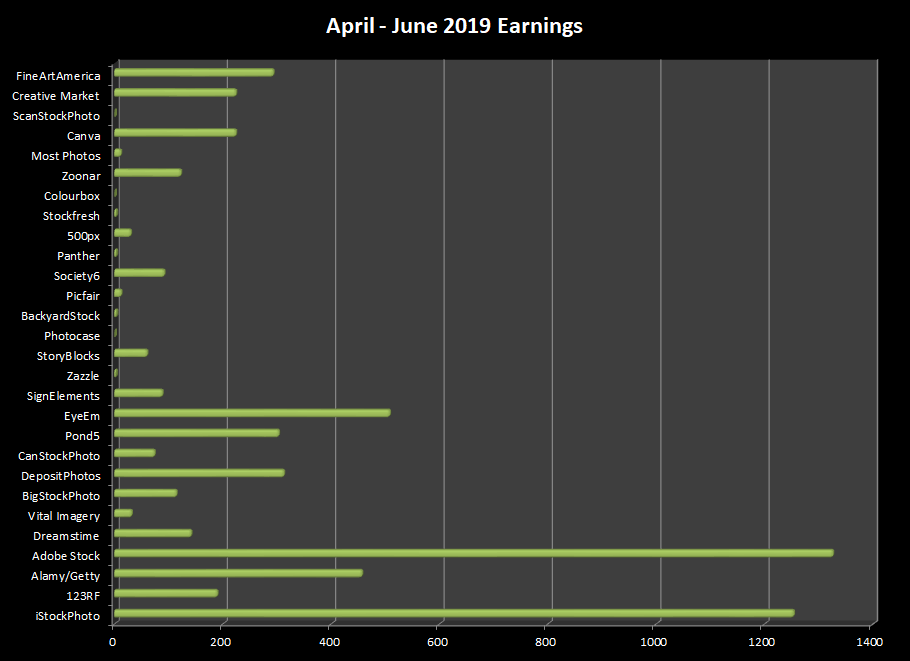Selling Photos – Quarter 2, 2019
After my June report on earnings from Stock Photography was published earlier this week, I worked on my massive spreadsheet to calculate the quarterly results and smooth out some of the monthly variants. The end result isn’t too pleasing, to be honest!
The total, $8524 is the lowest since the third quarter of 2017 when I earned $7818. Of course, one quarter may be a blip, but the evidence points to a continued decline in earnings per online file, which is how I judge whether my efforts to grow my portfolio are paying off in increased earnings. I calculate the figure by averaging the number of files I have on Shutterstock, iStock and AdobeStock over the three months to give me an idea of the size of the portfolio in that quarter. This quarter, the answer was 9850 files. I then calculated the earnings from all my agencies but removed video sales and Fine Art America sales as they are much higher in value and more of a one-off. The division of average files into total earnings from image sales gives me my earnings per online image:

What a depressing picture! Although the earnings per download might be flat, I am now getting 50% of the earnings from each file that I upload compared to 5 years ago, and the trend is unremittingly downwards with no end in sight. Well, to be honest – there is an end: when the earnings per image reaches zero. Mathematically speaking, that will occur in just over 3 years if the trend continues. It is hard to picture how that would happen, but I wish I could see a leveling off of the graph!
In terms of agencies over the quarter, as you would expect, Shutterstock was the highest earner with $2635. The other agencies look like this:
This chart shows how far some of the agencies have fallen, at least for me. Alamy is becoming a terrible seller and Dreamstime is dropping off a cliff. Canva looked OK in the quarter results, but with earnings of $25 in June, I expect that to become a blip against the axis in future results. Hard to think of much that is positive to say about these results!









So sad! The question is at how many cents the graph will level off if it does so at all. It’s logical that over the years the “value” of each file decreases as there are more and more files added to a cumulative sum. The offer seems to have risen more than the demand.
I feel like I have arrived late to the party of stockphotography and am asking myself whether it is still worth it to get into it.
Hi Adrian – I was thinking about this and, of course there is another potential answer. I have been adding a lot of travel shots to my portfolio – partly because I have traveled more and also because I am getting better at it. So I might be overloading my portfolio with shots with a lower value to buyers. They cost little to take and add (once you are there), but they don’t actually sell very often. It is the question I asked in that recent post about my images from the Adriatic cruise. So my saleable shots keep selling but my newer shots of travel destinations don’t because the market for them is smaller.
Steve
Perhaps the next analysis should be on types of image, travel, product, people etc…. is there decline across the board. Furthermore, does the age of an image reflect desirability? Do clients want a more recent image? Agencies capture the date taken of the image in the detail. If you did this analysis for images less than say 2-3 years old I wonder how it would look. Just a thought.
Good thoughts. This is an analysis that is quite hard to do because there are no common keywords that I can search my sales on. If I had put one keyword in each image to enable a later search, it would have been a no-brainer, but of course I didn’t. As my reply to Andy shows – there is potentially a benefit (and no cost) to having a portfolio with many occasional sellers as long as the cost of taking them is not high.
Steve
Saw something several years back. You may be familiar with it it’s called The Longtail. I didn’t have the patience to read the whole concept, but now might be the appropriate time.Maybe “Why the future of business is selling less of more” This may be too much to wrap my mind around.
What Is the Long Tail?
“The long tail is a business strategy that allows companies to realize significant profits by selling low volumes of hard-to-find items to many customers instead of only selling large volumes of a reduced number of popular items. The term was first coined in 2004 by Chris Anderson, who argued that products in low demand or with low sales volume can collectively make up market share that rivals or exceeds the relatively few current bestsellers and blockbusters but only if the store or distribution channel is large enough.”
Will have to give it more thought
Andy R
That is a good thought. The internet was supposed to make it economic to offer items that had only a small chance of selling by reducing the cost of holding stock etc. With my photos of Montenegro, for instance, they didn’t cost anything to produce because I was there anyway and I like taking photos, and as there is no cost to storing them with stock agencies, I might as well continue to build a portfolio that holds such occasional sellers. It spoils my stats, but might help my income!
Steve
I think your interpretation is good. In the “Old Days” of the stock photo industry there was a higher threshold to enter. Now with the internet, digital photography, photo editing software, the RF model and microstock agencies fiercely competing, adding massive numbers of files access is available to any one.
The plus and the minus. There were the professionals and then those with day jobs who sold some stock. Now you still have those with the addition of a vast number of others, among them hobbyists, amateurs (lovers of photography), retired.
So the scales have been tipped and a new equilibrium and balance has developed.
As you have so astutely noticed with your graphs things are changing.
Change is ever present.
I find the engineering, scientific, physicist, analytical mind fascinating.
Thanks
If you’ve seen Jim Pickerell’s Newsletter he recounts some of this history and many photographer’s frustration.
Thanks! I can pretend to be an artist but I can’t leave my engineering training behind! I like my new theory – I’ll have to think if I can test it somehow!
Steve
I saw this coming since 2013. The statistic showed that new uploaded images earned a much lower RPI than older uploads. The monthly RPI of all images were much higher, than only new ones. There must be a decline every month. It will get lower and lower. I don’t think it will reach zero, but near zero.
My stats show that in 3 years it will be more profitabel for me to give my images away for free to get traffic on Instagram and on my blog.
I mostly shoot food. If quit stock and built a free large food image and footage portfolio in the next years , it seems to be the better way.
Though using unsplash may be not the best way. Better would be running an own Agency. This would be expensive but will work I guess.
Interesting! You need a solid way of monetizing your blog or agency though. I did read an article about a photographer who put some images on Unsplash to drive traffic back to his site and get sales and work that way.
Steve
Thank you Steve for these enlightening insights. I wonder what you think of selling images as digital downloads on your own store or website. I’ve seen several photographers who do select some premium images and sell them as digital downloads for higher prices. Do you think this would be a good strategy if you do a proper marketing on Facebook or with other tools? Thanks.
I’ve tried it – put a ton of effort into building BackyardStockPhotos.com and have had pitiful results. It is very hard to compete with free and many people searching for images aren’t looking to pay for them. So although they may find your site, they aren’t willing to pay 99c for a legal download! I have tried a bit of Facebook advertizing without much success – I don’t know of anyone with a successful stock site of their own (unless they are illustrators who seem to do better at it)
Steve
Thank you all for such and informative set of questions and answers.
I also feel I got late to the party…!!!
Thanks Ray – it is definitely getting harder!
Hi Steve,
Good informative article.
It is disappointing but not unexpected.
Keep up the good work Steve.
Tai
Thanks!
Hi Steve,
I uploaded the first batch of 775 photographs to EyeEm last week. I’m working with other 14 agencies so far.
Regarding EyeEm I just realized the pictures doesn’t have a watermark nor other protection, and it’s easy to download the pictures in 1400 x 1050 pixels format without watermark. This is enough for web use and for some low budget publications.
What’s your opinion? I’m considering stopping working with EyeEm because of this risk. I know the watermark is not a big protection but the lack of watermark is like an invitation to use the images for free.
Congratulations for your good work and for sharing all your valuable information and experience.
Carlos
Hi Carlos – I agree that they have large images online and people can download those. But your best selling images are already available online with no watermarks and potentially at a larger size on the websites where they were legally bought and then used. So they are already out there to be stolen. I don’t bother really – if someone is going to steal and use it, they wouldn’t have paid anyway and so I am not losing anything.
Steve
Steve, thanks for the valuable insight. While the trend is indeed worrying to say the least, nearly 3 grand a month is still a decent money. Especially for those who happen to live in more affordable countries. I think even in the US lots of people do a 9 to 5 job for less. Frankly i’d be really happy to make that kinda money off of my stock portfolio – but sadly i was late to the party too and i’ve only 400 images on sale. So it’s a very long way to go.
Also, as you said yourself, travel as a niche is extremely oversaturated. This might affect your figures. I can’t even think of any method to make your way to the top 100 for a keyword that returns 25000 hits.
Unfortunately for the rest of us, both Mr Brutally Honest and yourself do mostly travel, and no one else shares their sales figures regularly, so we have no idea what other major niches look like. It might be very similar though.
Maybe selling footage has a few more good years before it inevitably meets the same fate. As i’m a graphic designer myself, i’ll also try to put more effort in producing illustration, 3D and creative concepts, and have a larger port at Arcangel and such agencies — the creative market is also competitive but maybe a bit less saturated. POD sites such as society6, FAA and red bubble are also more promising than micro is.
Hi Victor
Yes, I should always remind myself that the $3K is a very nice addition each month! Although I like travel, I probably find that 50% of my sales are local or studio shots. I sell quite a lot of images from the city I live in, because they are not as well represented, and I also try to keep abreast of the news and create images that meet a need there. As a graphics person, I think you have an advantage there as it is sometimes easier to create something than to find and photograph it. As you say, video has a lot of life in it – I find that harder and I’m sure many people are the same. Similarly, the PoD sites are interesting, but harder work I feel. As long as I don’t find it to be boring work, I plan to continue!
Steve
Great write up. Thank you very much for your effort doing this.
I think I have an answer to your “when it will reach ZERO ($ per download)” Though not a direct one. I do not know the date but I do know WHAT will happen.
The answer is that as the $ will continue to drop, more and more selling clients (aka contributors) will stop uploading or drop out altogether. But the number of buying clients will remain in sync with economies’ ups and downs. Thus with the demand ‘fixed’ and the supply dead, the agencies will move towards generating the content digitally, getting rid 99% of ‘contributors’. They will keep on selling the old pre-CGI content as long as clients want it. They will only stick with contributors that can turn on absolutely amazing content, on demand, and at a very reasonable price.
So no there is no end to the slide down that slope and yes it will be more than 0$ because of the logarithmic character of the function.
My own, calculated, not guessed, figure is somewhere between 5 and 10c per download. In about 2 to 3 years from now.
Too bad I have just spent some $$ on good equipment to shoot microstock and 4K in top shelf technical quality. This equipment will never pay for itself. Let alone making any reasonable amount of profit.
Best regards,
Yes, I have wondered about CGI content – certainly for model related stuff with products. Travel photography is a bit harder to create and more trouble to do that than it is worth probably. Still – keep going until the bottom drops out of the market and get at least some profit from your equipment!
Steve